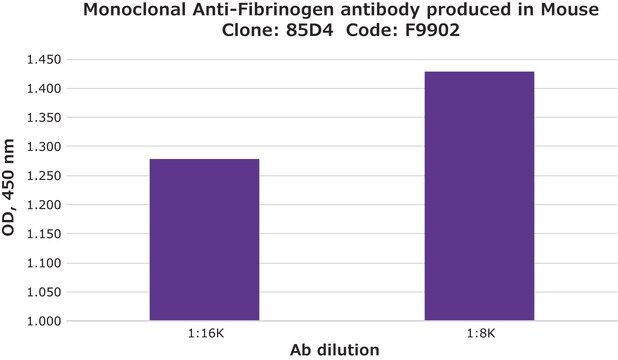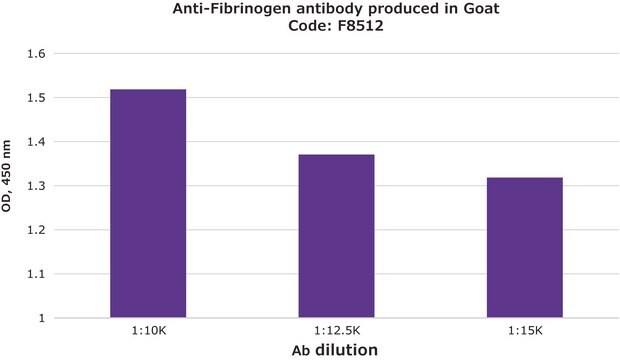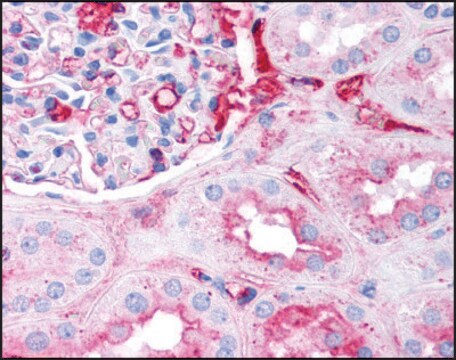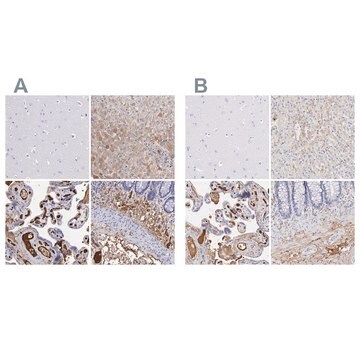F4639
Monoclonal Anti-Fibrinogen antibody produced in mouse
clone FG-21, ascites fluid
Se connecterpour consulter vos tarifs contractuels et ceux de votre entreprise/organisme
About This Item
Produits recommandés
Source biologique
mouse
Niveau de qualité
Conjugué
unconjugated
Forme d'anticorps
ascites fluid
Type de produit anticorps
primary antibodies
Clone
FG-21, monoclonal
Contient
15 mM sodium azide
Espèces réactives
human, baboon
Technique(s)
indirect ELISA: 1:4,000
Isotype
IgG2a
Numéro d'accès UniProt
Conditions d'expédition
dry ice
Température de stockage
−20°C
Modification post-traductionnelle de la cible
unmodified
Description générale
Fibrinogen, is a thrombin-coagulable soluble plasma 340kDa glycoprotein, composed of paired sets of three subunits i.e. α, β, γ. Among three subunits, β and γ subunits contain one N-glycosylation site, which is occupied by a biantennary N-glycan. It contains three pairs of disulfide bonded chains called α, β, γ which further folded into four structural domains: the D, E, connector and the COOH-terminal region of the Aα chain.
Monoclonal Anti-Fibrinogen (mouse IgG2a isotype) is derived from the hybridoma produced by the fusion of mouse myeloma cells and splenocytes from an immunized mouse.
Spécificité
The antibody is specific for human fibrinogen and recognizes an epitope sensitive to reduction commonly used in immunoblotting assays. It also reacts with synthetic human fibrinopeptides A and B, fibrinogen related peptides and baboon fibrinogen. No cross-reactivity with bovine, pig, sheep, horse, dog, goat, rabbit, guinea pig, or rat is observed.
Immunogène
purified haptoglobin from pooled human plasma containing the three major haptotypes.
Application
Monoclonal Anti-Fibrinogen antibody produced in mouse has been used in:
- enzyme linked immunosorbent assay (ELISA)
- immunoblotting
- fibrinogen adsorption assay
Actions biochimiques/physiologiques
Fibrinogen, a blood coagulation protein, is regarded as the central protein in the blood coagulation system.Fibrinogen plays a crucial role in protecting the vascular network against the loss of blood after tissue injury.
Plasmin attacks the Aα chain COOH domain to produce the heterogeneous fragment X. After a series of degradation, it ended with terminal digestion products: fragments D and E which represent the major globular domains in fibrinogen. Mutations in this gene leads to several disorders including hypofibrinogenemia, afibrinogenemia.
Clause de non-responsabilité
Unless otherwise stated in our catalog or other company documentation accompanying the product(s), our products are intended for research use only and are not to be used for any other purpose, which includes but is not limited to, unauthorized commercial uses, in vitro diagnostic uses, ex vivo or in vivo therapeutic uses or any type of consumption or application to humans or animals.
Vous ne trouvez pas le bon produit ?
Essayez notre Outil de sélection de produits.
Code de la classe de stockage
10 - Combustible liquids
Classe de danger pour l'eau (WGK)
nwg
Point d'éclair (°F)
Not applicable
Point d'éclair (°C)
Not applicable
Faites votre choix parmi les versions les plus récentes :
Déjà en possession de ce produit ?
Retrouvez la documentation relative aux produits que vous avez récemment achetés dans la Bibliothèque de documents.
Preservation of hematopoietic stem and progenitor cells from umbilical cord blood stored in a surface derivatized with polymer nanosegments
Higuchi A, et al.
Biomacromolecules, 9(2), 634-639 (2008)
Akon Higuchi et al.
Biomaterials, 24(19), 3235-3245 (2003-05-24)
We examined plasma protein adsorption and platelet adhesion to polysulfone (PSf) flat membranes coated with Pluronic with varying polyethylene oxide (PEO) block length. Adsorption of albumin, globulin and fibrinogen to Pluronic-coated PSf membranes was independent of plasma dilution when concentrations
Identification of Apo-A1 as a biomarker for early diagnosis of bladder transitional cell carcinoma
Li H, et al.
Proteome Science, 9(1), 21-21 (2011)
N E Kirschbaum et al.
The Journal of biological chemistry, 265(23), 13669-13676 (1990-08-15)
The COOH-terminal portion of the A alpha chain of human fibrinogen is highly susceptible to proteolytic degradation. This property has prevented isolation of the COOH-terminal domain of fibrinogen for the direct investigation of its functional characteristics. Human fibrinogen was degraded
Y Fang et al.
Haemophilia : the official journal of the World Federation of Hemophilia, 12(6), 615-620 (2006-11-07)
Congenital afibrinogenaemia is a rare autosomal recessive disorder, characterized by the complete absence or extremely reduced level of fibrinogen (Fg). We attempted to analyse the phenotype and genotype in two Chinese families with congenital afibrinogenaemia. Coagulation studies including activated partial
Notre équipe de scientifiques dispose d'une expérience dans tous les secteurs de la recherche, notamment en sciences de la vie, science des matériaux, synthèse chimique, chromatographie, analyse et dans de nombreux autres domaines..
Contacter notre Service technique








